Who we are
The Electromagnetic Sensing Group at The University of Manchester specialise in electromagnetic sensing techniques across a very wide bandwidth – from DC to microwave, applying these techniques to solving real-world problems such as demining and technologies for public safety.
Our team is made up of senior and early career researchers, PhD students and administrative staff, bringing together a wealth of expertise to advance electromagnetic sensing research.
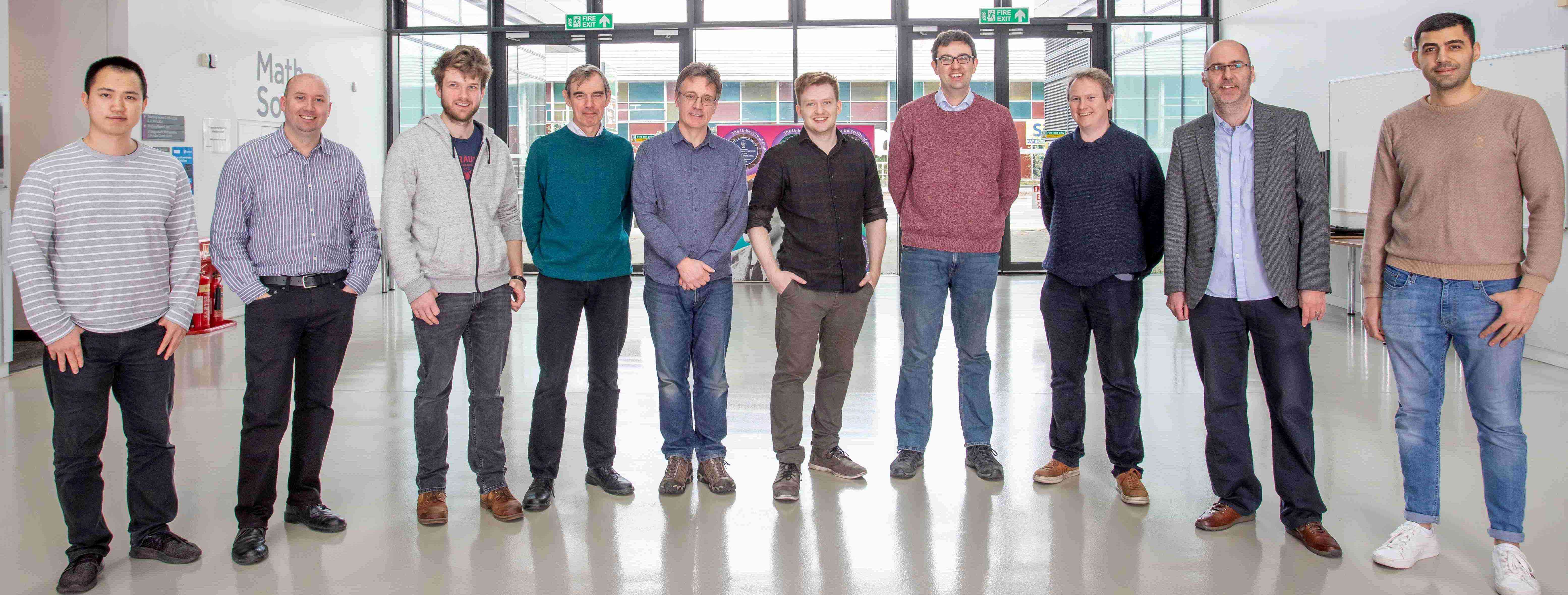
Full team list
James Anderson
James is the group’s Project Manager. Joining the University of Manchester in 2008 James worked for over 10 years in medical research administration before moving to the Electromagnetic Sensing Group, with his main focus being the group’s humanitarian demining project. Contact James
Daniel Conniffe
Daniel is an EngD student, looking at AR for NDE applications, having previously worked as a Research Assistant in the group focusing on the mechanical design and construction of our metal detector systems. Contact Daniel
David Daniels CBE
David is a Visiting Professor in Short Range Radar Systems. David has a wide range of experience both in academia and industry, having previously worked at Cobham Technical Services, and is an internationally acknowledged expert on ground-penetrating and ultrawideband radar. Contact David
John Davidson
John is a Research Associate. John has worked across the group’s research projects and has a particular interest in electromagnetic modelling, inverse problems and magnetic induction sensor development. John’s current research is focused on higher order tensor measurements. Contact John
Adam Fletcher
Adam is a Research Associate. Having originally completed his PhD at The University of Manchester, Adam undertook a period in industry with EDF Energy before returning to work on the group’s humanitarian demining project, specifically developing electromagnetic detection techniques. Contact Adam
Bill Lionheart
Bill is a Professor in Applied Mathematics in The Department of Mathematics. As co-investigator for a number of the group’s projects he has played a major role in providing the mathematical underpinning of the group’s demining and security research. Bill’s main research interest is Inverse Problems including a wide range of imaging techniques. Read Bill’s full research profile
Liam Marsh
Liam is a Lecturer in Embedded Systems. Liam has played a leading role in the group’s humanitarian demining project and has a particular research interest in the areas of metal detection and characterisation, magnetic induction spectroscopy & tomography, signal processing, remote sensing and security. Read Liam’s full research profile
Michael O’Toole
Mike is a Lecturer in Magnetic Induction Systems. Mike has worked on a number of the group’s projects, including security screening and food screening, and has a particular research interest in bioimpedance and magnetic induction spectroscopy. Read Mike’s full research profile
Tony Peyton
Tony is a Professor in Electromagnetic Tomography and is Principal Investigator on multiple projects across the research spectrum of the group, working extensively with industry, charitable partners and other research groups both in the UK and internationally. Tony’s main areas of interest are instrumentation, applied sensor systems, and electromagnetics. Read Tony’s full research profile
Frank Podd
Frank is a Lecturer in Embedded Systems with a wide array of experience in both academia and industry. Frank is particularly interested in the field of ground-penetrating radar as applied to humanitarian demining and agriculture, and radar use in security screening. Read Frank’s full research profile
Soumya Rana
Soumya is a Research Associate. Prior to joining the group Soumya worked as a Research Associate at London South Bank University following the completion of his PhD in 2020. His research interests includes microwave brain and breast imaging, UWB motion analysis, and deep learning.
Kane Williams
Kane is a Research Associate working on the use of magnetic induction spectroscopy for the classification of non-ferrous metals for scrap recycling. This is a continuation of the work Kane undertook for his PhD, also as a member of the Electromagnetic Sensing Group, which he completed in March 2024. Read Kane’s full research profile
John Wilson
John is a Research Associate working primarily in the area of non-destructive testing, with a particular interest in the NDT of microstructure and continuous annealing. John has also been heavily involved in the group’s buried object detection projects looking at meteorite recovery in the polar regions. Read John’s full research profile
Wuliang Yin
Wuliang is a Reader in Electromagnetic Sensors and Instrumentation. Wuliang has authored one book and over 200 journal publications and been granted more than 10 patents in the area of electromagnetic sensing and imaging. Wuliang’s current research is focused on the use of electromagnetic techniques in non-destructive testing. Read Wuliang’s full research profile
Our research covers three main areas of expertise, each of which has ongoing activities and collaborative partners:

This area of our research examines how we can make safety improvements in areas of public health and resource production.
It includes work in the following specific areas:
Food inspection
Every biological tissue, including food, has its own bioimpedance profile – more commonly referred to as its bioimpedance spectra. Simply put, this is how an individual tissue reacts at a cellular and molecular level to different electromagnetic frequencies. By measuring the spectra we can understand how the tissue’s cells are structured, and, in the context of food inspection, potentially determine the quality of food without the need for expensive and wasteful sample inspection. A fast, reliable, non-contact method to determine a food’s bioimpedance spectra has the potential to offer multiple benefits to the food industry in terms of cost-saving, time efficiency and an increased product yield.
Current work
To accomplish this we developed a multi-frequency magnetic induction spectroscopy system (MIS) for the measurement of food’s bioimpedance spectra, which scans the food item as it passes on a conveyor belt. Testing a range of food samples, such as apples, oranges and potatoes, the system has been shown to be consistently capable of measuring food’s bioimpedance spectra at a near-industrial speed of 1.5s a sample. While the system is still very much at a laboratory stage, our aim is to work with our partners in the food industry to develop a system fit for commercial use. The system also has potential benefits for the medical and pharmaceutical industries.
Partners
The research underpinning the MIS system was conducted as part of the EU-wide Fruitgrading Project funded by the European Union’s Seventh Framework Programme for research, technological development and demonstration. Technical support has also been provided by our long-term industry collaborators Mettler-Toledo Safeline.
Group expertise
- Bioimpedance spectroscopy
- Multi-frequency magnetic induction spectroscopy
- Novel equipment manufacture.
Medical diagnostics
Current work
Having commenced in 2019, ABRIMS is currently in the first phase of a four-part work programme, concentrating on the development of a clinical wideband bioimpedance spectroscopy system. The next phases will see the team carry out trials in a clinical setting, undertake large-scale data analysis and modelling, and find a suitable pathway for dissemination and technology transfer.
Partners
ABRIMS is funded by the UK Engineering and Physical Sciences Research Council and is a close partnership between the EM Sensing Group and our collaborators at the Salford Royal NHS Foundation Trust, chiefly clinical scientist Dr. Stuart Watson, Head of Clinical Research and Development at SRFT, and NIHR clinical scientist Dr. Adrian Parry-Jones, Senior Lecturer in Vascular Neurology at The University of Manchester and Honorary Consultant Neurologist at the Greater Manchester Comprehensive Stroke Centre, SRFT.
Group expertise
- Radio-Frequency Induction (RFI)
- Microwave Spectroscopy
- Advanced Computer Modelling
- Biomedical Engineering

This area of our research examines how we can make efficiencies in our social infrastructures, and safely organise and dispose of the waste we produce.
It includes work in the following specific areas:
Microstructure analytics
Current work
In the field a three-head sensor system is currently active at steel giant Tata Steel’s number 2 Hot Strip Mill at the IJmuiden plant, Netherlands, with further installations being discussed at plants internationally. In terms of research the EM Sensing Group is now looking at advancing this area to move away from solely monitoring the process, to understand how to control it. This is chiefly being undertaken by two projects, the EPSRC funded RIME (Real Time In-Line Microstructure Engineering) project and the EU Research Fund for Coal and Steel funded OMA II project (Online Microstructure Analytics).
Partners
The EMspec® technology was developed in conjunction with Siemens, and has been licenced by University of Manchester Intellectual Property Limited , UMIP® (now the University of Manchester Innovation Factory) to Primetals Technologies. Tata Steel have provided the industrial test site and the ongoing research is being undertaken in collaboration with The University of Warwick and our industrial partners British Steel, Sheffield Forgemasters International, and Tenaris.
Group expertise
- Electromagnetic sensing
- Multi-frequency signal processing
- Electromagnetic properties of steel
- Non-destructive testing for harsh environments
Nuclear inspection
Supplying around a fifth of the UK’s electrical energy, EDF-Energy’s 14 Advanced Gas-cooled Reactors (AGRs) represent a major contribution to the UK’s energy mix. As such, ensuring that these reactors are able to operate safely for as long as possible without being replaced is of major importance both to EDF-Energy in operational terms, and wider society environmentally – their continued use means there is no need to replace the reactors with other, more environmentally damaging means of energy production. In a decade long partnership, the EM Sensing Group and EDF-Energy have worked together to develop a novel, non-destructive solutions to a potential limitation of AGRs, the ageing of graphite bricks within the reactor’s core.
Current work
As the graphite bricks within AGRs age they are prone to a loss of density, which in turn may lead to structural changes within the core and ultimately the need to retire reactors. Currently, inspection of the graphite bricks is undertaken through the trepanning of physical samples – a time-intensive process which is carried out during scheduled shutdowns and clearly there is a limit to the number of samples that can be taken during the shutdown period. We have developed a non-destructive method of testing the graphite bricks whereby a sensor system is able to take electromagnetic measurements of the bricks’ density at different depths – allowing for a complete picture of the bricks’ structural integrity to be realised. The project is now approaching the end goal of translating this laboratory-based research into a physical inspection instrument for routine use in AGRs. If successful, it is hoped that the technology may have applications in other NDT fields.
Partners
As well as EDF-Energy, this area of research has received extensive funding support from EPSRC under grant number EPSRC IAA 122. We have future work planned in this area which has received funding from the European Union under grant no. 945273.
Group expertise
- Resistivity and conductivity profiling
- Multi-frequency eddy-current modelling
Scrap sorting
As the climate crisis and its consequences become increasingly apparent, how we can achieve sustainable use of our planet’s resources without further, prolonged environmental damage is a global challenge. Recycling will play a central role, and in the area of non-ferrous metals, large quantities of metal can be recovered from end-of-life white goods, vehicles and electrical waste, with the processing of this recycled metal being up to 95% more energy efficient than using new materials. However, current methods for scrap sorting are either time-consuming and inefficient, as with sorting scrap by hand, or damaging to the environment, with what is known as the dense media separation technique relying on the largescale use of slurries. There is therefore a real need for a technique which sorts scrap quickly, efficiently, and safely, without causing further environmental harm.
Current work
Building on a history of successful University research, our current project with industry, Metal-ID, aims to meet this need through the development of a sensor system capable of identifying different types of metal by measuring how they react to alternating magnetic fields at different frequencies – their impedance spectra. Once the metals have been scanned their spectra is then analysed using statistical and machine learning algorithms to identify different metals based on their electrical conductivity. In collaboration with our industrial partner Magnapower, world leaders in the area of metal separation, we aim to produce industrial prototypes of a separations system using our sensor array which will offer fast, reliable and environmentally friendly metal separation technology for the recycling industry.
Partners
Previous work in this area has been funded by the European Union’s Seventh Framework Programme, grant no. 603676, and recent work is funded by Innovate UK Smart Grant 72207.
Group expertise
- Electromagnetic tensor spectroscopy
- Metals classification
- Eddy-current sensors

This area of our research examines how we can make the world a safer place for the people who live in it.
It includes work in the following specific areas:
Humanitarian demining
Since 2011, the Electromagnetic Sensing Group has been working in partnership with The Sir Bobby Charlton Foundation to apply our expertise in the area of electromagnetics to the field of humanitarian demining.
An estimated 100m active landmines still remain in post-conflict areas such as Cambodia and Angola, disproportionately affecting countries of lower socio-economic status. The presence of landmines in these areas acts a roadblock to farming and infrastructure development, as well as presenting a daily threat of injury and loss of life to an area’s inhabitants.
Our goal is to combine cutting edge metal characterisation, ground-penetrating radar and positioning research into a single detector to be made available at an acceptable cost for humanitarian organisations.
Ultimately it is hoped that this detector will enable more land to be cleared at a faster rate, improving the lives of those people living in landmine affected areas.
Current work
Now in its final phase following basic research and technology transfer work, the SEMIS project is currently working towards the final goal of getting the detector into the field in partnership with Guartel Technologies Ltd.
Partners
SEMIS has been funded and developed in close collaboration with the Sir Bobby Charlton Foundation (formerly Find A Better Way). This charity was set up Sir Bobby Charlton following his experience visiting minefields in Cambodia in the 1990s. We are extremely grateful for the charity’s support.
Through the SEMIS project the group has also built a strong contact base with the Mines Advisory Group (MAG), HALO Trust and other world leaders in the field of demining.
Group expertise
- Ground Penetrating Radar (GPR)
- Multi-frequency Spectroscopic Metal Detection
- Metal Characterisation
- Position Measurement
Lost meteorites
While helping to understand the origins of the Solar System might not normally fall within the our group’s remit, this is the ultimate goal of a project the group has lent its metal detection expertise to over the last 5 years – The Lost Meteorites of Antarctica. Led by Drs Katherine Joy and Geoff Evatt, the project is a collaboration between University of Manchester researchers in the Departments of Earth and Environmental Sciences, Mathematics, and Electrical and Electronic Engineering to recover iron-rich meteorites from Antarctica. It is hoped that an analysis of these meteorites’ age, structure and chemistry will offer clues to how planets first formed in the early Solar System.
Current work
Our role in this project has been to develop a bespoke detection system to uncover those meteorites thought to be buried around 300 mm beneath the ice in Antarctica. This system is a 6 m wide detector array pulled by skidoos capable of travelling 15 km/h and able to scan 1 km2 in under 12 hours. Following field trials in the Svalbard region of the Arctic Circle, the detector arrays were deployed by the Lost Meteorites team on the Outer Recovery blue ice fields in November 2019.
Representing the EM Sensing Group, Wouter Van Verre took part in the daily search for meteorites as well as providing engineering support for the detector system. Unfortunately, no sub-surface meteorites were able to be detected on this expedition and the detector array encountered a number of unexpected difficulties on the region’s hard ice. However, there were several valuable lessons learned regarding the detector array and the project has now collected over 100 on-surface meteorites. An excellent account of the trials, tribulations and successes of the Lost Meteorites mission can be found on the UK Polar Meteorite Exploration and Research blog.
Partners
The project has been funded by the Leverhulme Trust with support from the British Antarctic Survey (BAS).
Group expertise
- Large scale, robust metal detection for extreme terrain
People screening
Knife and gun crime represent a significant threat to public safety, both in the UK and internationally, with close to 2.5 million knife-related criminal incidents recorded in the UK in the last decade, and over 300 handgun related deaths in a similar period. Effective screening for knife and guns in public places obviously offers a greater degree of safety to the general public, however current walk-through metal detectors are extremely time consuming, requiring the public to individually remove any metallic objects from their person, with the potential to cause major delays to the flow of the general public.
To help solve this problem we have pioneered a technique called Locating Characterising Metal Detection (LCMD), which measures an object’s magnetic polarizability tensor (MPT) as it passes through a magnetic field. Using the MPT’s signature, we can then compare it to a library of objects’ MPTs and classify it as a threat (handgun, knife) or innocuous (e.g. jewellery).
Current work
The current focus of this research is the Smart Metal Detector project, in collaboration with Metrasens Ltd. and Rapiscan Systems. This project hopes to build on our previous research to design a prototype detector, capable of measuring the MPT signatures of all metallic objects carried by a person passing through the detector for immediate comparison with our MPT signature library, and automatic classification as a threat or innocuous item.
This has the potential to achieve a sea change in the way people screening works, with accurate discrimination of small items, including handguns and knives, achievable without the need to interfere with the flow of the general public. We believe that this detector could offer a low cost, easily deployable solution for high footfall public spaces such as shopping centres, schools, nightclubs and sports stadia. Work has now commenced on the Smart Metal Detector project and we hope to begin reporting results from 2021 onwards.
Partners
Work in this area has been undertaken in collaboration with industry partners Rapiscan Systems, and Metrasens Ltd., as well as mathematics colleagues at The University of Swansea. We have received industry funding from Rapiscan Systems Ltd. and government funding via UK Research and Innovation and EPSRC, under grant nos. 39814, and EP/R002134/1.
Group expertise
- Multi-frequency induction sensors and systems
- Impedance spectroscopy
- Eddy-current technology transfer

Photo credit: Andrew Smedley
Current job and PhD opportunities
Manchester Minesweeper Competition
The Manchester Minesweeper Competition was a public engagement initiative funded by the Royal Academy of Engineering which ran between June and July 2023, and saw 9 secondary schools from across Greater Manchester compete in a month-long competition to build the best minesweeper robot, learning fundamental electrical engineering skills. The competition finale included the teams navigating their robots around a track, identifying metal objects boxes, and a 3-minute pitch on their robot design judged by a team of Electrical and Electronic Engineering undergraduates . The event culminated with the arena challenge where teams each had a few minutes to search for hidden metal objects, moving their robot around our danger zone while avoiding the obstacles.

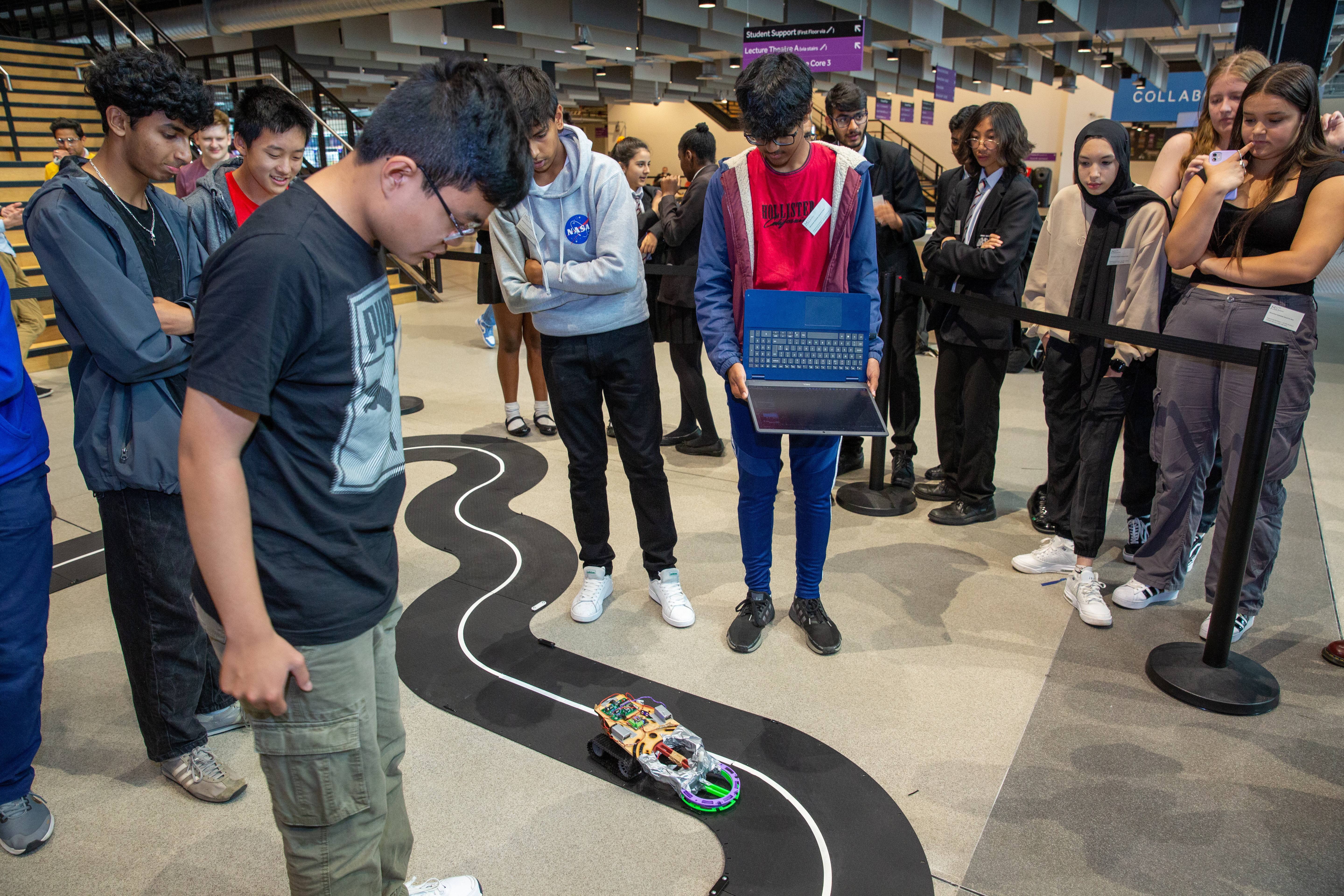
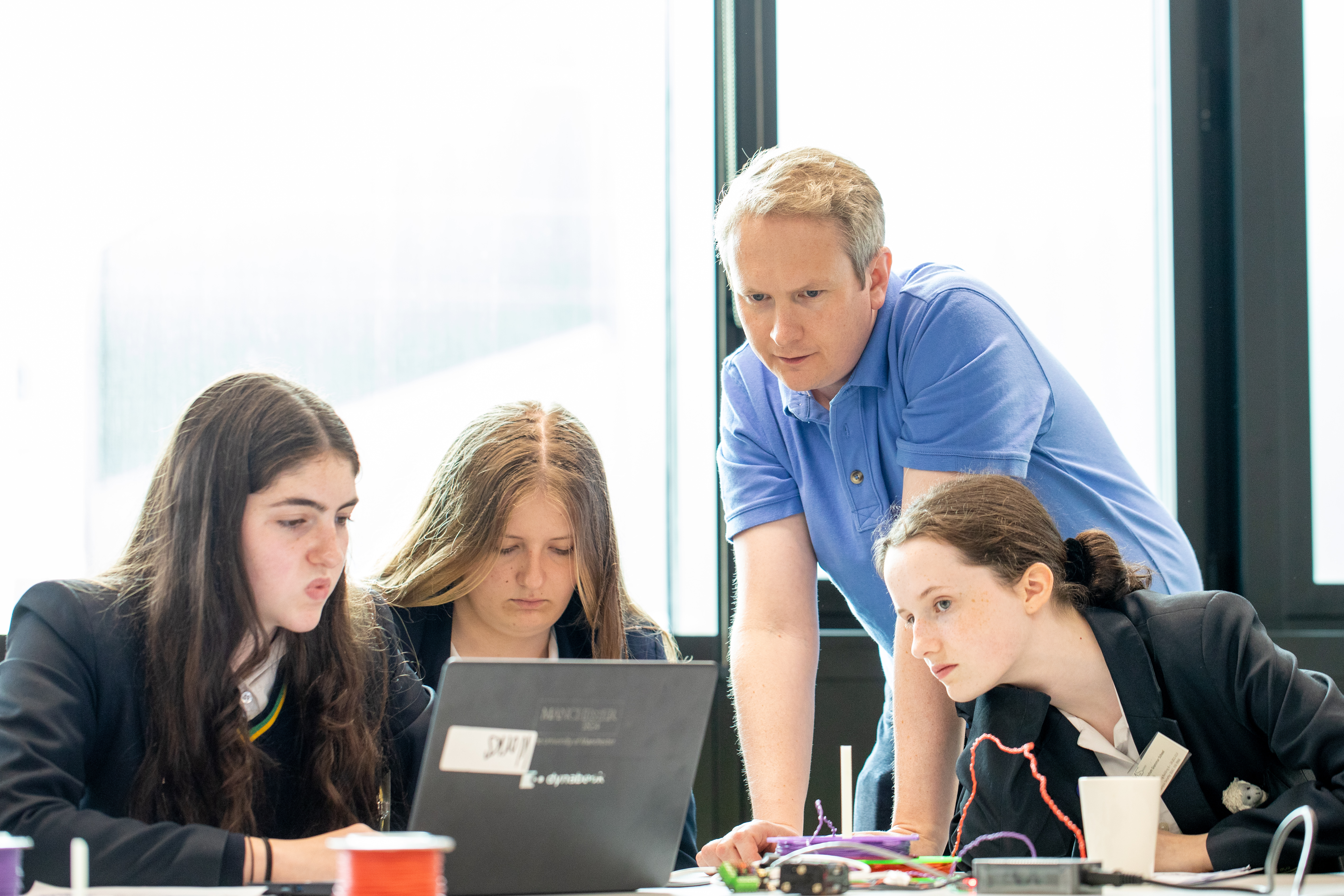
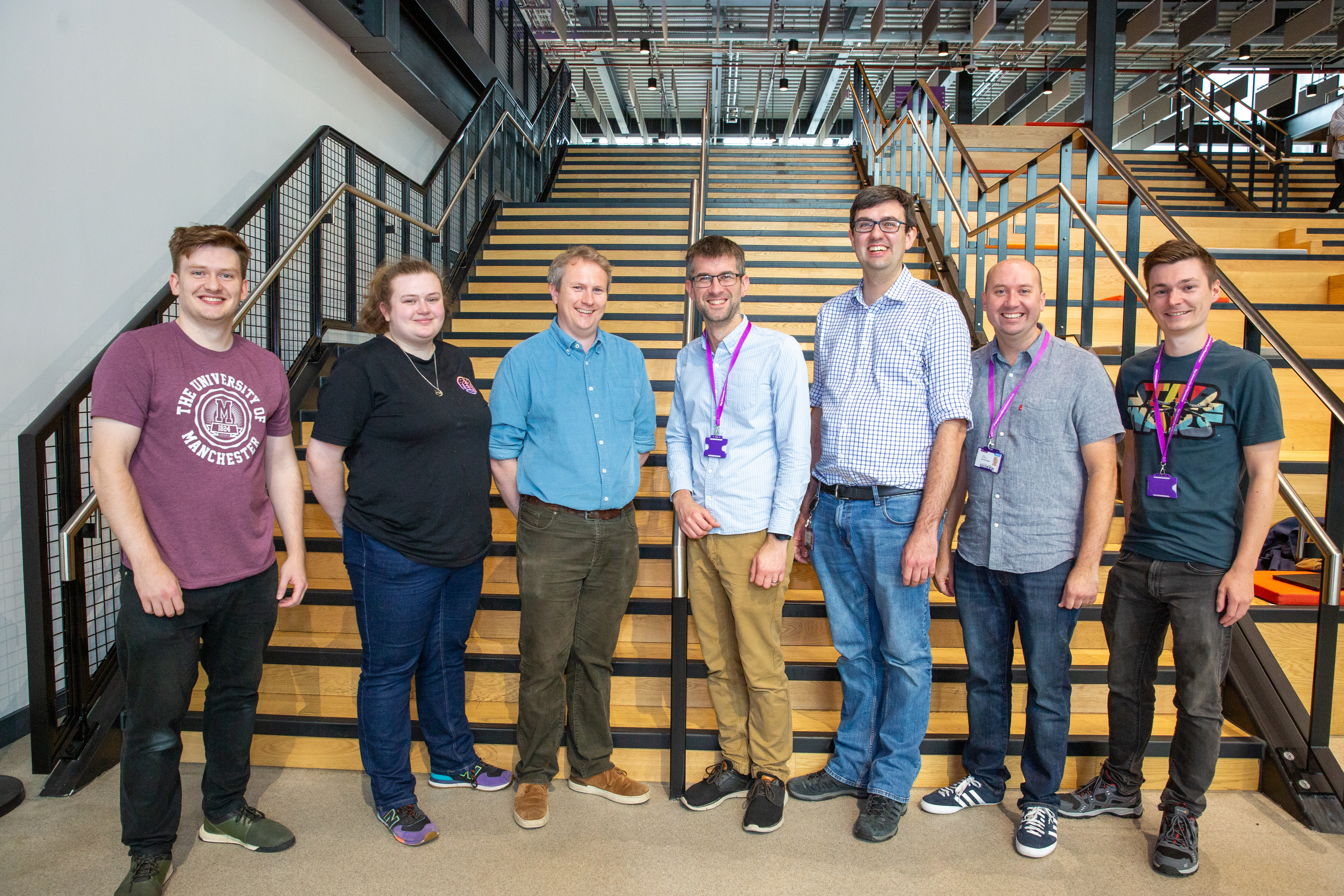
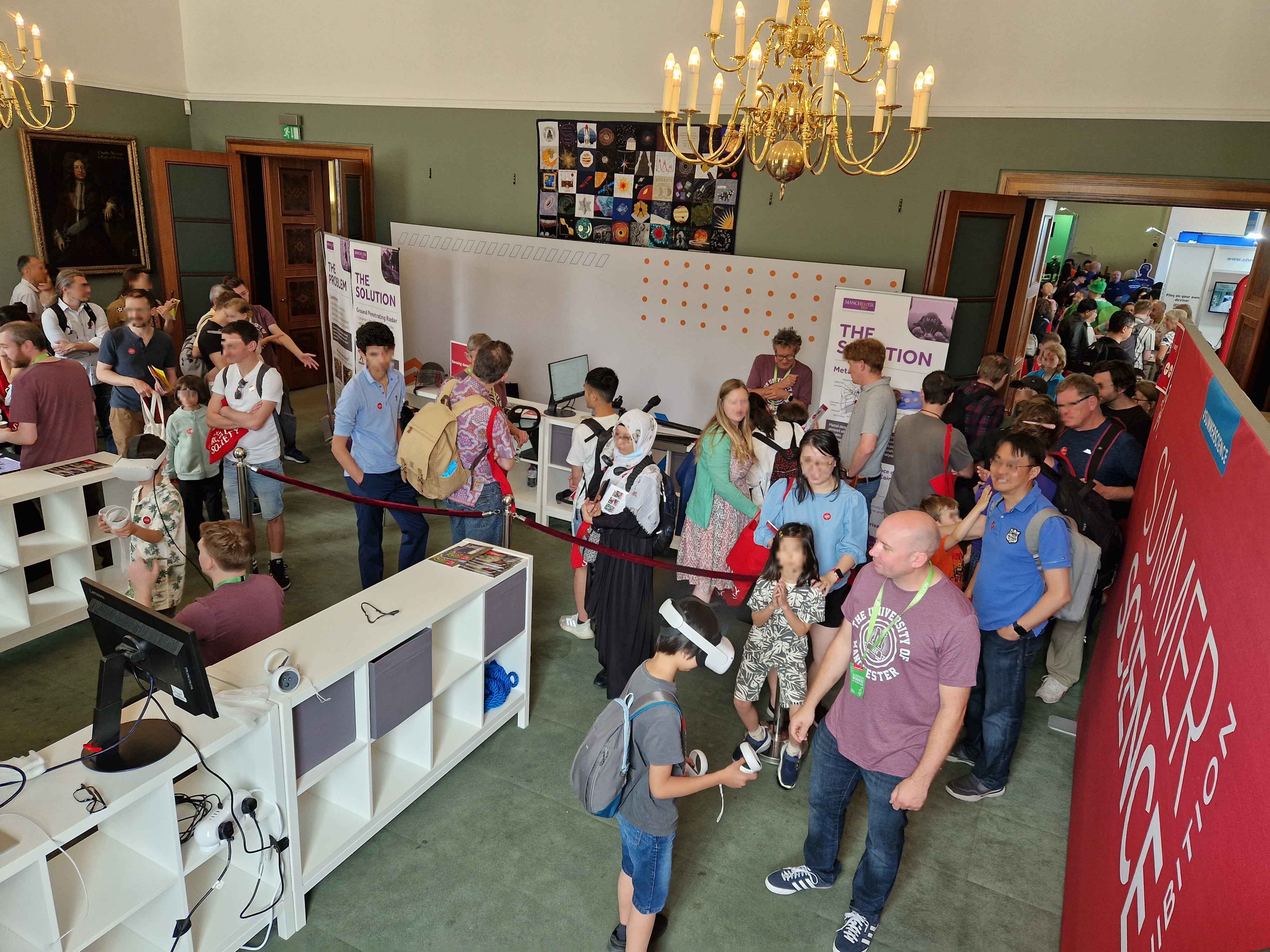
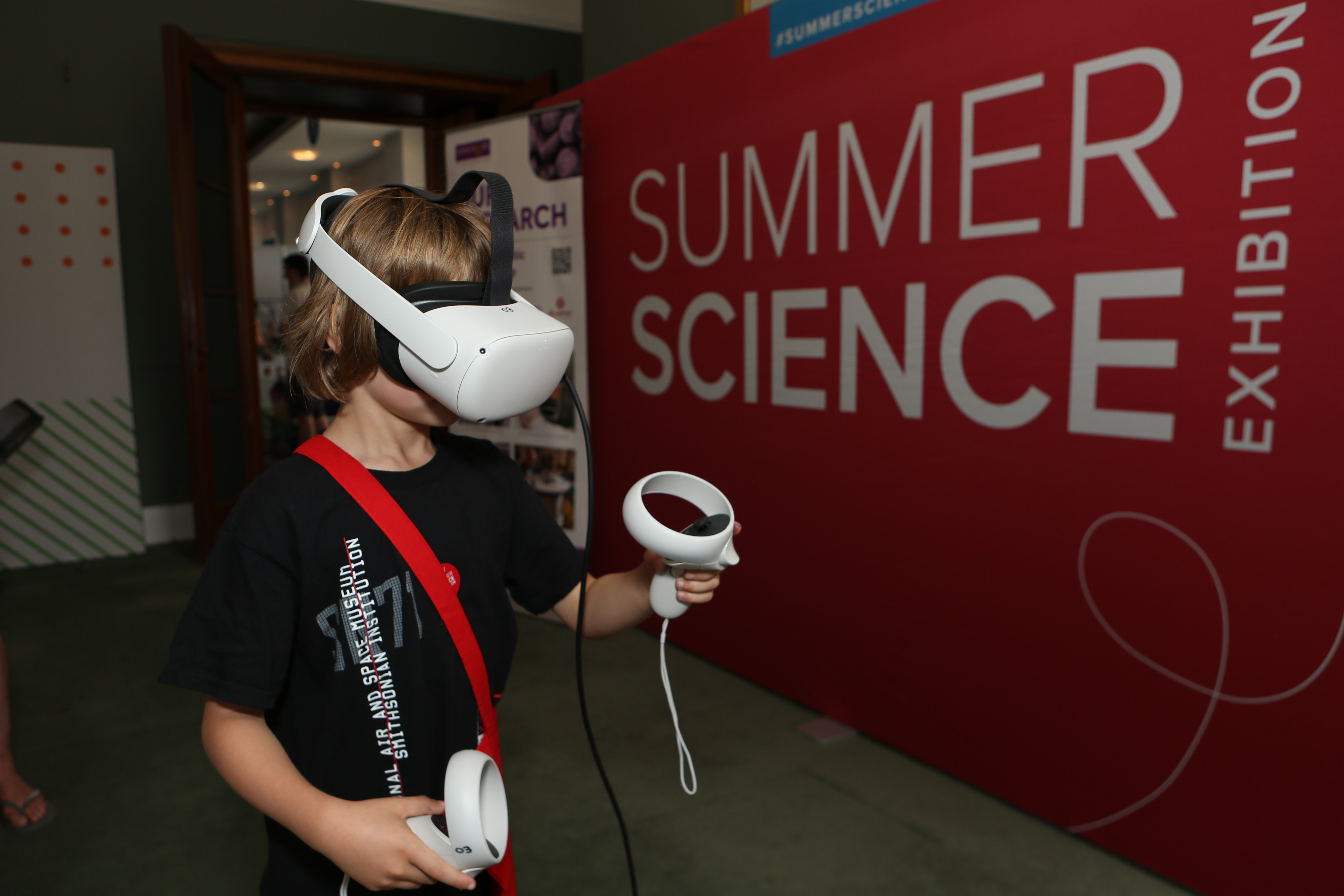
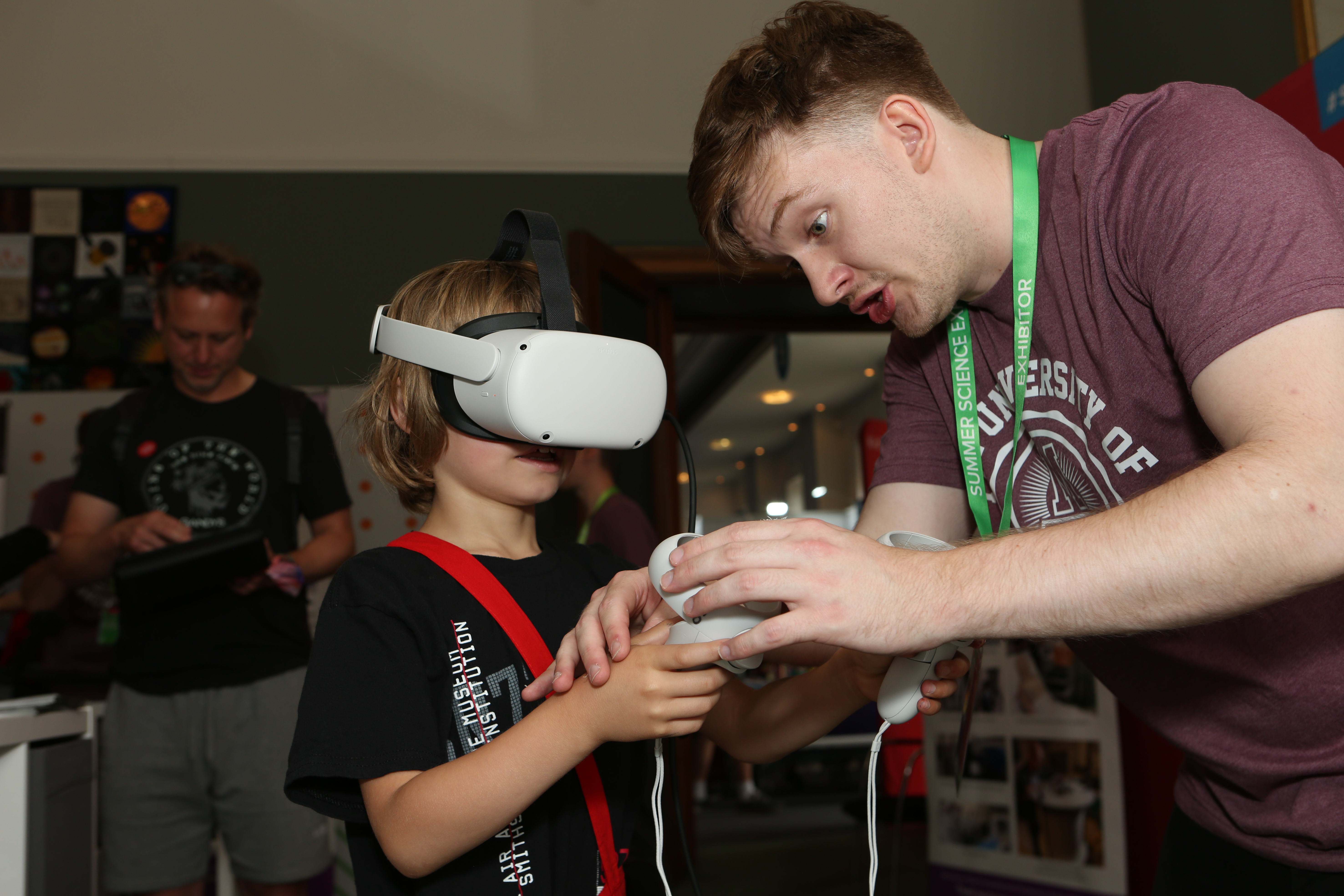

Sensing Danger
Sensing Danger is an outreach activity, focussed around the group’s work on the design and manufacture of a novel dual-modality detector system, which allows the public to experience humanitarian demining themselves via a VR demo, as well as learning about the complexities of sub-surface detection through AR demonstrations. This has been run at local and national events in 2023 including British Science Week; The University of Manchester Community Festival, and The Royal Society Summer Science Exhibition (left), reaching over a thousand members of the general public.
Sensing Danger
Sensing Danger is an outreach activity, focussed around the group’s work on the design and manufacture of a novel dual-modality detector system, which allows the public to experience humanitarian demining themselves via a VR demo, as well as learning about the complexities of sub-surface detection through AR demonstrations. This has been run at local and national events in 2023 including British Science Week; The University of Manchester Community Festival, and The Royal Society Summer Science Exhibition (left), reaching over a thousand members of the general public.




Previous Events
Sensing Danger, a digital forerunner of the above physical exhibit, which we ran at the Royal Society Summer Science Showcase 2021, is an interactive experience highlighting the science behind detection and the global effort to rid the world of landmines. In many parts of the world landmines are still a huge problem – there are over 100 million landmines still active – and we show how our group’s research, in collaboration with the Sir Bobby Charlton Foundation, is using cutting edge science to find a better solution to the landmine challenge and meet the Landmine Free 2025 goal.
The group have also undertaken public engagement activities previously at Cheltenham Science Festival, The Museum of Science and Industry Platform for Engagement and other events.
Outreach Resources
How To Build A Metal Detector Video

Contact us
Get in touch with the Electromagnetic Sensing Group by email:

